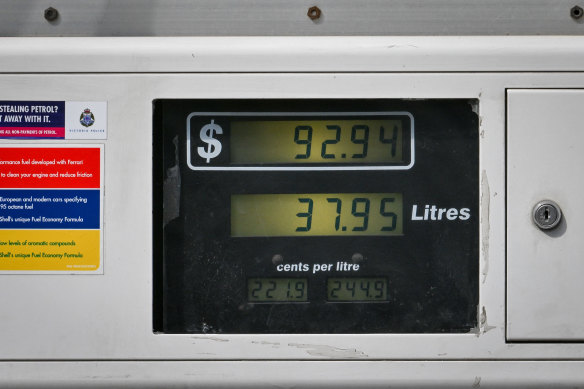This was published 2 years ago
Opinion
Petrol prices won’t crash the housing market – it’s renters who will suffer most
Emma Dawson
ContributorI don’t drive much. We live in the inner suburbs, it’s an easy walk to my daughter’s school and the local shops, and I’ve got public transport options within a 10-minute walk that will get me to the city in less than half an hour.
So, it’s been a while since I last filled up the car – probably more than a month – and when I found myself running on fumes on the way home from a kid’s birthday party on Sunday, I pulled into the nearest servo. It had cost me over $90 to fill up last time, which was painful enough, but on the weekend that full tank of petrol set me back almost $120 – a third as much again. Ouch.

Petrol prices will cool the housing market but there’s little chance they will undo the gains of the past year.Credit: Eddie Jim
As has been widely noted, a government cut to the fuel excise, as was recently done in New Zealand, may provide some immediate relief at the bowser. Even if we abolished the excise altogether, we would only return petrol costs to where they were in January – and there’s no sign the global forces driving up the cost of oil will dissipate any time soon.
Australians rely on their cars more than the residents of comparable nations and until electric vehicles are widely available, there isn’t an alternative fuel. For many Australians, that 33 per cent increase comes out of their wallet weekly or fortnightly, depending on how often they fill up. It’s a highly visible cost-of-living increase: with the price per litre literally up in lights at every service station, it’s impossible to ignore, or to avoid.
Another big increase in the price of an essential item was revealed in the latest ABS statistics out this week: the cost of a house in Australia grew by 23.7 per cent in the 12 months to December 31, the largest increase on record. Unlike soaring petrol costs, rising property prices are usually regarded as good news, as they add to the wealth of property owners, and therefore to the wealth of the nation.
Despite the inexorable growth of house prices over recent decades locking an increasing number of people out of the market, the demand for property has continued to grow apace. With interest rates at record lows, we did not see the fall in house values that some predicted as a result of the pause in immigration and economic shock brought about by the pandemic.
The average house in an Australian capital city increased by around three times the average salary of an Australian worker in 2021: if you’re a metropolitan homeowner, you’d have to be in the top 5 per cent of income brackets to have earned more than your house did over the past 12 months. As figures released on Tuesday by the Australian Council of Trade Unions revealed, the average worker on $68,000 has $800 less each year due to the rising cost of living over the same period.
It seems badly out of whack, doesn’t it? If our incomes are falling as the cost of essential items like petrol and food are on the rise, how are we still pumping so much money into the housing market? Won’t the hit to household budgets of these salient cost increases begin to soften property prices, particularly with an interest rate rise on the cards this year?
Probably not by much – and certainly not enough to reverse the extraordinary gains of the past two years. Existing property owners with a decent amount of equity in their homes, whether owner-occupiers or investors, shouldn’t worry about petrol prices affecting the value of their assets.
This is because housing, arguably in Australia more so than just about any other developed nation, does not respond to price shocks in essential items as do other consumer goods. We have, through successive policy interventions (or lack thereof) in both the supply and demand side of the market, repositioned housing within our economy as a capital good: a source of investment rather than a source of shelter.
The price of petrol could soar another 33 per cent and we’d see little impact on house prices. While looming interest rate rises will undoubtedly cool speculative investment, the demand for homes continues to outstrip supply, and various tax concessions make property a more attractive choice for small investors than more productive options.
Where the sharp increases in cost of living brought about by petrol price rises will hurt is at the bottom end of the housing market: those in private rentals, some of whom may still be hoping to buy their first home.
Lower income households – the bottom 40 per cent, predominantly living on fixed income support, sometimes combined with part-time or casual wages from insecure work – pay more than 3 per cent of their income on petrol, compared to less than 2 per cent for higher income earners. They also spend a much greater proportion of their income on essentials, leaving little to save for a home deposit – or to cover increases in rent, which are beginning to follow house prices up that steep incline.
These are the same households who live in the outer suburbs, poorly serviced by public transport and often several kilometres from local schools and shops. They fill up their cars weekly, and clock big distances commuting to their jobs. An extra $30 a week, for them, could be the difference between having a roof over their heads, or none. Cost of living pressures? Those are ones that hurt.
Emma Dawson is executive director at Per Capita.